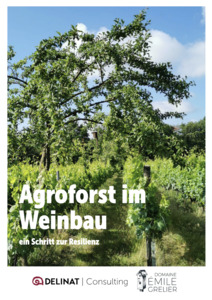{Tool} Agroforestry in viticulture - A step towards resilience. [Agroforst im Weinbau - Ein Schritt zur Resilienz.] Creator(s): Bastide, Inès; Vinet, Maud and Vinet, Benoît. Issuing Organisation(s): Delinat. (2022)
![[thumbnail of Bildschirmfoto 2025-05-05 um 15.33.53.png]](/55597/1.hassmallThumbnailVersion/Bildschirmfoto%202025-05-05%20um%2015.33.53.png)  Preview |
Image (PNG)
- Cover Image
- German/Deutsch
2MB |
Preview |
PDF
- Published Version
- German/Deutsch
1MB |
Preview |
PDF
- Published Version
- Italian/Italiano
1MB |
Preview |
PDF
- Published Version
- Spanish/Español
1MB |
Preview |
PDF
- Published Version
- French/Francais
1MB |
Preview |
PDF
- Supplemental Material
- UNSPECIFIED
147kB |
Document available online at: https://www.delinat.com/delinat-methode/agroforst.html
Summary
In this guide, you'll learn more about the long-standing connection between trees and grapevines, about additional hedges in viticulture systems and their benefits for biodiversity, about root systems, about microbial biodiversity in the soil, about microclimate, and trees as carbon stores and water pumps. You'll also receive numerous practical tips for implementing trees in viticulture systems.
| EPrint Type: | Practice tool |
|---|---|
| Teaser: | Guide for agroforestry in viticulture and list of suitable trees for your vitiforst. |
| What problem does the tool address?: | The grapevine is a plant that reacts sensitively to environmental conditions. Climate change and its extreme weather phenomena (drought, aridity, gusts of wind, heavy rainfall) pose major challenges. Agroforestry offers a promising solution to this problem. This form of management combines the cultivation of plants with the cultivation of trees and shrubs. This leads to interactions between the various components, strengthening the ecosystem of the plots. |
| What solution does the tool offer?: | Grapevines and trees make good partners. The grapevine is naturally a wild vine that connects to the tree to thrive, using the trunk and branches for support. Unfortunately, the Industrial Revolution and its vision of linear mechanization transformed vineyards into treeless monocultures with bare soils. This disastrous development not only contributes to climate change through the release of carbon, but also leads to the impoverishment of soils and landscapes due to insufficient biodiversity. The vines themselves become weaker and more vulnerable to diseases and natural forces. Trees have important and diverse qualities. They can sequester carbon and positively influence the climate. They also have agronomic abilities to improve the soil and safeguard biodiversity. Trees and shrubs are good windbreakers and have a positive influence on water balance and natural nutrient supply. Cultivated with them, the vine benefits and makes it less susceptible to diseases and pests. A sensible combination of vines, trees, and shrubs, as envisioned by agroforestry, is a forward-looking solution for sustainable organic viticulture. |
| Country: | Switzerland |
| Type of Practice Tool: | Leaflets & guidelines |
| Keywords: | climate change, climate change adaptation, climate-smart agriculture, resilience, horticulture, cropping systems, agroecology, agroecosystems, biodiversity, nature conservation |
| Agrovoc keywords: | Language Value URI English climate change http://aims.fao.org/aos/agrovoc/c_1666 English climate change adaptation http://aims.fao.org/aos/agrovoc/c_1374567058134 English climate-smart agriculture http://aims.fao.org/aos/agrovoc/c_1361789093890 English resilience http://aims.fao.org/aos/agrovoc/c_1374480530924 English horticulture http://aims.fao.org/aos/agrovoc/c_3671 English cropping systems http://aims.fao.org/aos/agrovoc/c_1971 English agroecology http://aims.fao.org/aos/agrovoc/c_92381 English agroecosystems http://aims.fao.org/aos/agrovoc/c_36669 English biodiversity http://aims.fao.org/aos/agrovoc/c_33949 English nature conservation http://aims.fao.org/aos/agrovoc/c_5092 |
| Subjects: | Crop husbandry > Crop combinations and interactions Environmental aspects > Biodiversity and ecosystem services Crop husbandry > Production systems > Fruit and berries > Viticulture |
| Research affiliation: | European Union > Horizon Europe > OrganicClimateNET > selected tools European Union > Organic Farm Knowledge Switzerland > Other organizations Switzerland |
| Horizon Europe or H2020 Grant Agreement Number: | 101136880 |
| Related Links: | https://organic-farmknowledge.org/tool/55597, https://organicclimatenet.eu/, https://organic-farmknowledge.org/tool/54364, https://organic-farmknowledge.org/tool/54003 |
| Project ID: | OFK |
| Deposited By: | Rüger, Madelaine Lea |
| ID Code: | 55597 |
| Deposited On: | 05 May 2025 14:08 |
| Last Modified: | 12 May 2025 12:18 |
| Document Language: | German/Deutsch, French/Francais, Italian/Italiano, Spanish/Español |
| Status: | Published |
Repository Staff Only: item control page

 Download Statistics
Download Statistics Download Statistics
Download Statistics
